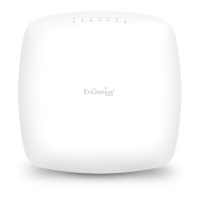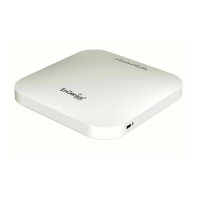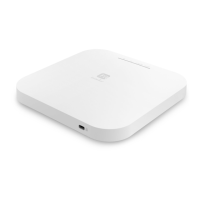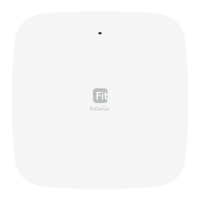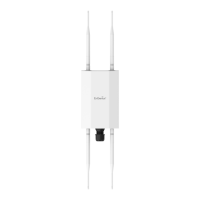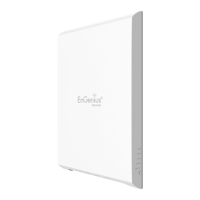Do you have a question about the EnGenius EWS377AP and is the answer not in the manual?
Lists key features of the EnGenius AP, including Wi-Fi standards, data rates, and management capabilities.
Details the minimum system requirements for configuring the EnGenius Access Point, including computer and software needs.
Lists all the items included in the product packaging for the EnGenius Access Point.
Outlines the technical details of the EnGenius Access Point, covering standards, interfaces, power, and operating modes.
Describes the physical dimensions, weight, and port layout of the EnGenius Access Point, including LED indicators.
Guides users on configuring computer network settings, specifically for Windows XP, 7, 8, and 10, for network compatibility.
Provides instructions for configuring network settings on Apple Mac OS X systems for compatibility with the Access Point.
Details the steps for physically connecting the EnGenius Access Point, including Ethernet cables and power sources.
Explains how to mount the EnGenius Access Point on a wall or ceiling using the provided hardware.
Specifies the default IP address, username, and password for accessing the EnGenius Access Point's configuration interface.
Guides users on how to access and configure the EnGenius Access Point through a web browser interface.
Explains the functionality of the Access Point when operating in AP mode, connecting clients to the network.
Displays current operating status information of the EnGenius Access Point, including device and memory information.
Provides lists of connected clients for 2.4 GHz/5 GHz bands and WDS links, showing MAC addresses and signal strength.
Monitors real-time performance metrics of the Access Point, including CPU loading and traffic statistics.
Allows configuration of the device's IP settings, including static or DHCP assignment for IPv4 and IPv6.
Configures Spanning Tree Protocol settings to prevent network loops, including Hello Time, Max Age, and Priority.
Configures general wireless settings, including device name and advanced features like Band Steering and Band Balance.
Sets up wireless network parameters for both 2.4 GHz and 5 GHz bands, including operation mode, channel, and data rate.
Allows creation and configuration of up to sixteen SSIDs for both 2.4 GHz and 5 GHz bands, including security and VLAN settings.
Configures wireless security modes, including WEP, WPA2-PSK, and WPA2-Enterprise with passphrase and encryption settings.
Implements MAC address filtering to control network access for wireless clients, allowing or denying access based on MAC addresses.
Regulates packet flow and bandwidth for improved Quality of Service, allowing limits for download, upload, and per user.
Enables seamless roaming for mobile clients between Access Points, requiring specific SSID and security configurations.
Assigns VLAN tags to packets for network segmentation, allowing management of tagged traffic for the Access Point.
Configures SNMP settings for network monitoring, including contact details, location, community names, and trap destinations.
Enables and configures Command Line Interface (CLI), Secure Shell (SSH), and HTTPS for secure network device management.
Sets the internal clock of the Access Point, including manual or automatic date/time synchronization and daylight saving options.
Configures automatic reboot schedules for the Access Point to ensure stable operation and periodic resets.
Creates schedules to enforce network access rules, allowing or restricting Wi-Fi availability based on day and time.
Provides diagnostic tools like Ping and Traceroute for analyzing network connection quality and tracing routes.
Allows changing the Access Point's administrator username and password for secure access control.
Guides on upgrading the Access Point's firmware to the latest version for improved features and security.
Saves current device configurations for backup and restores them, including options for factory or user default settings.
Manages system logs, allowing viewing of internal logs and configuration of remote logging for monitoring events.
Provides options to securely log out of the system or reset the Access Point to factory or user default settings.
Details the process of connecting and configuring Access Points through an EnGenius Wireless Management Switch.
Explains how to deploy and manage EnGenius Access Points using the ezMaster centralized network management system.
Provides the Federal Communication Commission's statement regarding the device's compliance with radio frequency interference regulations.
Details Industry Canada's statement on the device's compliance with radio frequency interference and operation rules.
Presents the CE (Conformité Européenne) statement for EU compliance, including frequency, power, and declaration of conformity.
Lists key features of the EnGenius AP, including Wi-Fi standards, data rates, and management capabilities.
Details the minimum system requirements for configuring the EnGenius Access Point, including computer and software needs.
Lists all the items included in the product packaging for the EnGenius Access Point.
Outlines the technical details of the EnGenius Access Point, covering standards, interfaces, power, and operating modes.
Describes the physical dimensions, weight, and port layout of the EnGenius Access Point, including LED indicators.
Guides users on configuring computer network settings, specifically for Windows XP, 7, 8, and 10, for network compatibility.
Provides instructions for configuring network settings on Apple Mac OS X systems for compatibility with the Access Point.
Details the steps for physically connecting the EnGenius Access Point, including Ethernet cables and power sources.
Explains how to mount the EnGenius Access Point on a wall or ceiling using the provided hardware.
Specifies the default IP address, username, and password for accessing the EnGenius Access Point's configuration interface.
Guides users on how to access and configure the EnGenius Access Point through a web browser interface.
Explains the functionality of the Access Point when operating in AP mode, connecting clients to the network.
Displays current operating status information of the EnGenius Access Point, including device and memory information.
Provides lists of connected clients for 2.4 GHz/5 GHz bands and WDS links, showing MAC addresses and signal strength.
Monitors real-time performance metrics of the Access Point, including CPU loading and traffic statistics.
Allows configuration of the device's IP settings, including static or DHCP assignment for IPv4 and IPv6.
Configures Spanning Tree Protocol settings to prevent network loops, including Hello Time, Max Age, and Priority.
Configures general wireless settings, including device name and advanced features like Band Steering and Band Balance.
Sets up wireless network parameters for both 2.4 GHz and 5 GHz bands, including operation mode, channel, and data rate.
Allows creation and configuration of up to sixteen SSIDs for both 2.4 GHz and 5 GHz bands, including security and VLAN settings.
Configures wireless security modes, including WEP, WPA2-PSK, and WPA2-Enterprise with passphrase and encryption settings.
Implements MAC address filtering to control network access for wireless clients, allowing or denying access based on MAC addresses.
Regulates packet flow and bandwidth for improved Quality of Service, allowing limits for download, upload, and per user.
Enables seamless roaming for mobile clients between Access Points, requiring specific SSID and security configurations.
Assigns VLAN tags to packets for network segmentation, allowing management of tagged traffic for the Access Point.
Configures SNMP settings for network monitoring, including contact details, location, community names, and trap destinations.
Enables and configures Command Line Interface (CLI), Secure Shell (SSH), and HTTPS for secure network device management.
Sets the internal clock of the Access Point, including manual or automatic date/time synchronization and daylight saving options.
Configures automatic reboot schedules for the Access Point to ensure stable operation and periodic resets.
Creates schedules to enforce network access rules, allowing or restricting Wi-Fi availability based on day and time.
Provides diagnostic tools like Ping and Traceroute for analyzing network connection quality and tracing routes.
Allows changing the Access Point's administrator username and password for secure access control.
Guides on upgrading the Access Point's firmware to the latest version for improved features and security.
Saves current device configurations for backup and restores them, including options for factory or user default settings.
Manages system logs, allowing viewing of internal logs and configuration of remote logging for monitoring events.
Provides options to securely log out of the system or reset the Access Point to factory or user default settings.
Details the process of connecting and configuring Access Points through an EnGenius Wireless Management Switch.
Explains how to deploy and manage EnGenius Access Points using the ezMaster centralized network management system.
Provides the Federal Communication Commission's statement regarding the device's compliance with radio frequency interference regulations.
Details Industry Canada's statement on the device's compliance with radio frequency interference and operation rules.
Presents the CE (Conformité Européenne) statement for EU compliance, including frequency, power, and declaration of conformity.
| 5 GHz | Yes |
|---|---|
| MIMO type | Single User MIMO |
| Modulation | 16-QAM, 64-QAM, 256-QAM, 1024-QAM, BPSK, CCK, QPSK |
| Transmitting power | 23 dBmW |
| Networking standards | IEEE 802.11a, IEEE 802.11ac, IEEE 802.11b, IEEE 802.11g, IEEE 802.11i, IEEE 802.11k, IEEE 802.11n, IEEE 802.11r, IEEE 802.3at |
| Ethernet LAN data rates | 2500 Mbit/s |
| Maximum data transfer rate | 2400 Mbit/s |
| Output current | 1.25 A |
| Output voltage | 12 V |
| Power consumption (max) | 19.5 W |
| Package width | 245 mm |
| Package height | 85 mm |
| Package weight | 866 g |
| Master (outer) case width | 442 mm |
| Master (outer) case height | 230 mm |
| Master (outer) case length | 502 mm |
| Master (outer) case weight | 9660 g |
| Harmonized System (HS) code | 85176990 |
| Quantity per master (outer) case | 10 pc(s) |
| Antenna gain level (max) | 3 dBi |
| Storage temperature (T-T) | -30 - 80 °C |
| Operating temperature (T-T) | 0 - 40 °C |
| Operating relative humidity (H-H) | 0 - 90 % |
| Security algorithms | AES, SSH, SSID, WPA2-Enterprise |
| USB 2.0 ports quantity | 0 |
| Ethernet LAN (RJ-45) ports | 1 |
| Internal | No |
| Placement | Ceiling, Wall |
| Certification | FCC, CE |
| Product color | White |
| LED indicators | LAN, Power, WLAN |
| Width | 205 mm |
|---|---|
| Height | 33.2 mm |
| Weight | 560 g |



